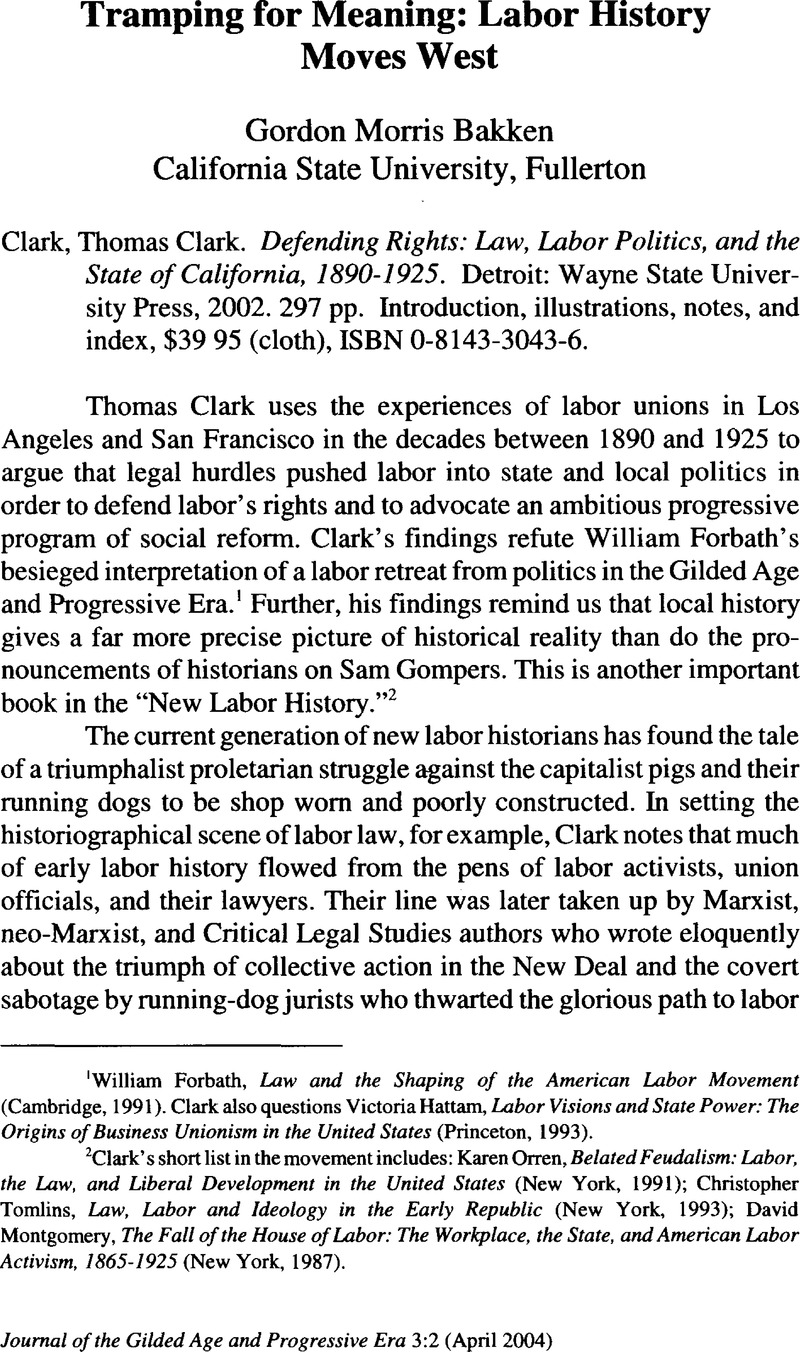No CrossRef data available.
Published online by Cambridge University Press: 08 November 2010

1 Forbath, William, Law and the Shaping of the American Labor Movement (Cambridge, 1991).Google Scholar Clark also questions Hattam, Victoria, Labor Visions and State Power: The Origins of Business Unionism in the United States (Princeton, 1993).CrossRefGoogle Scholar
2 Clark's short list in the movement includes: Orren, Karen, Belated Feudalism: Labor, the Law, and Liberal Development in the United States (New York, 1991)Google Scholar; Tomlins, Christopher, Law, Labor and Ideology in the Early Republic (New York, 1993)CrossRefGoogle Scholar; Montgomery, David, The Fall of the House of Labor: The Workplace, the State, and American Labor Activism, 1865–1925 (New York, 1987).CrossRefGoogle Scholar
3 Clark singles out Karl Klare, Raymond Holger, and Alan Dawley as representative “Crits” whose interpretations must be overturned by his findings. Clark, , Defending Rights, 65.Google Scholar
4 The context for the view that judges were the mere pawns of big business and acted at their behest is Horwitz, Morton, Transformation of American Law, 1780–1860 (Cambridge, 1977).Google Scholar Largely repudiated on a factual basis, the Horwitz thesis nicely fits into the neo-Marxist agenda for labor law studies. For a summary of the debate and a bibliography see Karsten, Peter, Heart versus Head: Judge-Made Law in Nineteenth-Century America (Chapel Hill, 1997), 325–28.Google Scholar
5 Clark, , Defending Rights, 20.Google Scholar
6 Kimeldorf, Howard, Battling for American Labor: Wobblies, Craft Workers, and the Making of the Union Movement (Berkeley, 1999)Google Scholar looks at the Philadelphia longshoremen. Nelson, Bruce, Divided We Stand: American Workers and the Struggle for Black Equality (Princeton, 2001)Google Scholar compares eastern longshoremen and steel workers with a focus upon race. See also McCartin, Joseph, Labor's Great War: The Struggle for Industrial Democracy and the Origins of Modern American Labor Relations, 1912–1921 (Chapel Hill, 1997)Google Scholar; Wood, Stephen B., Constitutional Politics in the Progressive Era: Child Labor and the Law (Chicago, 1968)Google Scholar; Whiteside, James, Regulating Danger: The Struggle for Mine Safety in the Rocky Mountain Coal Industry (Lincoln, 1990)Google Scholar; Bakken, Gordon Morris, The Development of Law on the Rocky Mountain Frontier: Civil Law and Society, 1850–1912 (Westport, CT, 1983)Google Scholar; Rocky Mountain Constitution Making, 1850–1912 (Westport, 1985); and Law in the Western United States (Norman, 2000).
7 It is clear that Hurst, James Willard set the bar high in Law and Economic Growth: The Legal History of the Lumber Industry in Wisconsin, 1836–1915 (Cambridge, 1964).Google Scholar The book is 929 pages in length. Pages 627–929 contain the double-column small print footnotes.
8 The decision of the California Supreme Court calls into question the weight historians should give to Ernst, Daniel, Lawyers Against Labor: From Individual Rights to Corporate Liberalism (Urbana, 1995).Google Scholar
9 Novkov, Julie, Constituting Workers, Protecting Women: Gender, Law, and Labor in the Progressive Era and New Deal Years (Ann Arbor, 2001).CrossRefGoogle Scholar Novkov looks at state courts, federal trial courts and the United States Supreme Court and concludes that gender was a critical factor in the development of labor law.